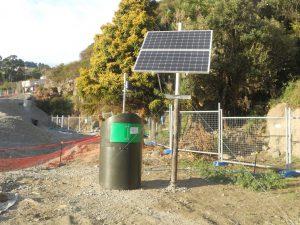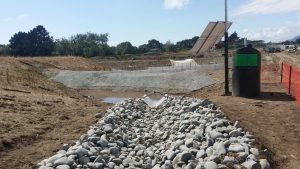Sediment Control
Coagulants and flocculants:
Flow activated
What, why, and when
What
Flow-activated treatment devices operate as follows:
- Dirty water flows down a channel and into a sediment retention pond (SRP) or decanting earth bund (DEB), and is detected by the system sensor
- Reagent is released to match the flow in the channel according to the settings you have entered into the system
- The sensor detects increases or decreases of the dirty water flow and automatically adjusts the dosing of reagent.
A flow-activated system is appropriate for many liquid reagents. Seek specific advice from suppliers of flow-activated systems and flocculants. Talk to suppliers about the options available to find the system that works the best for your site and project.
Why
Flow-activated treatment is the most precise option for treating sediment-laden runoff, because it provides a reagent dose-rate to match the flow of water into retention tools.
With this system there is little risk of overdosing the water as delivery is more precise than other systems. For example, runoff at the start and end of rainstorms can be difficult to treat reliably with a rainfall-activated system. Also, a rainfall-activated system will not dose water pumped within a site to the dirty water channel above a sediment retention tool – whereas all flows in the channel will be detected and treated by a flow-activated system.
The delivery of mixes of reagents can also be made easier by the use of a flow-activated system.
When
Flow-activated systems are best used with liquid reagents and are mainly used in the following situations:
- The period of treatment is long (more than 4 weeks)
- The catchment area is greater than 0.5 ha
- Earthworks are during periods of increased rainfall (eg winter)
- The site is unattended for more than 24 hours.
Design essentials
A flow-activated flocculent treatment device is made up of:
- A detection and delivery system that can sense all flows into the sediment retention pond. This means that all dirty water lows will be detected and dosed and not bypassed.
- A well-constructed and armoured section of the dirty water channel so that the flow-sensing device works accurately.
- A dosing control box that is secured against vandalism, wind and flooding.
- Adjustable system settings to develop a dosage curve for varying flows in the channel.
Estimate the flow in the channel based on the catchment size and rainfall intensities from normal rainfall events up to 20% AEP events.
Carry out bench testing and testing while the system is running to determine the optimal dose.
The flocculent should discharge to the turbulent section of the inlet drain, to make sure that it mixes thoroughly with the dirty water. For example, at least 5 metres upstream of the sediment retention pond (SRP) forebay.
Flocculent reservoir
- Maintain enough flocculent in the reservoir to dose the maximum amount of runoff from the catchment
- The dosing point of the outlet into the sediment-laden diversion should be at least 5 m upstream of the forebay to promote mixing of the flocculent.
Construction, operation and maintenance
When constructing a flow-activated treatment system
- Secure the box to prevent tampering, vandalism or storm damage
- Put the box somewhere that allows servicing and maintenance in all weathers
- Make sure that there are no flows into sediment retention tools that bypass the flow sensor.
When operating and maintaining a rainfall-activated treatment system
- Only implement treatment under the supervision of a suitably experienced and qualified professional
- Assess maintenance requirements before and after every rainfall event, or during exceptionally heavy and/or prolonged rainfall
- Remove any sediment that has accumulated around the flow sensing system and delivery flume so that the correct dosing rate and delivery is maintained
- If the site will be unattended for weekends or other periods, service the treatment system so that the maximum amount of runoff can be treated by the dosing system
- The system may require some ongoing adjustment to suit the site characteristics and runoff
- Regularly check that all dirty water flows go past the sensor and none bypass or outflank it
- Make sure that any dirty water pumped within the site for treatment goes past the flow sensor so that it is effectively treated.
Refilling the flocculent reservoir
- When the volume of flocculent in the reservoir tank is reduced so much that there would not be enough to dose a major storm, refill the flocculent reservoir
- Follow the supplier’s instructions as to the best way to refill the reservoir.
Monitoring and adjusting for changing site conditions
- Monitor each new treatment system carefully during the first few rainfall events to check that it is effective, and that there is no over or under-dosing.
- Monitor the clarity of water in the pond to understand whether you achieving the results needed.
- Changes in catchment areas and/or soils will also require a review of the treatment system set up. Significant changes may require a modification of the dosing curve.
- If you suspect overdosing because the pond dead storage water is exceptionally clear, re-check your treatment arrangements.
- Take samples from the pond for pH and residual chemical analysis. Adjust the dosing regime depending on the outcome of these results.
- If overdosing occurs, or if it is clear that the quality of stormwater runoff is improving because of stabilisation of the site, reduce the reagent dose from the system. Confirm the new dosing rate by testing the dosage that is required to treat the reduced sediment load in runoff.
- Remove sediment if it accumulates around the flow sensing equipment or the reagent delivery tube.
- Deal with issues such as poor treatment performance, or consistently very clear treated water, by consulting a suitably experienced and qualified professional.
Spill management
- If there is a reagent spill onto the ground, contain it immediately using earth bunds so that the spill can’t enter water. When using PAC, recover any spilt reagent that you can and put it in polyethylene containers. If you can’t recover it, mix it with at least ten times the amount of soil, to neutralise the PAC. Bury this soil at least 0.5 m below the ground surface.
- If there is a reagent spill into ponded water, prevent discharge from the pond to natural water. Then sample and test the ponded water to confirm whether it is safe to discharge. For example with PAC, check that the pH and or free aluminium concentration is within acceptable limits.
- If there is a spill of reagent into flowing water:
- Contact the Pollution Hotline immediately: 0800 POLLUTE
- Record the volume of the spill
- If possible, pump the water and spilt reagent into a bund or pond until all the spilt reagent has been removed from the watercourse
- If you can’t remove the reagent from the watercourse, identify and advise any downstream users.

